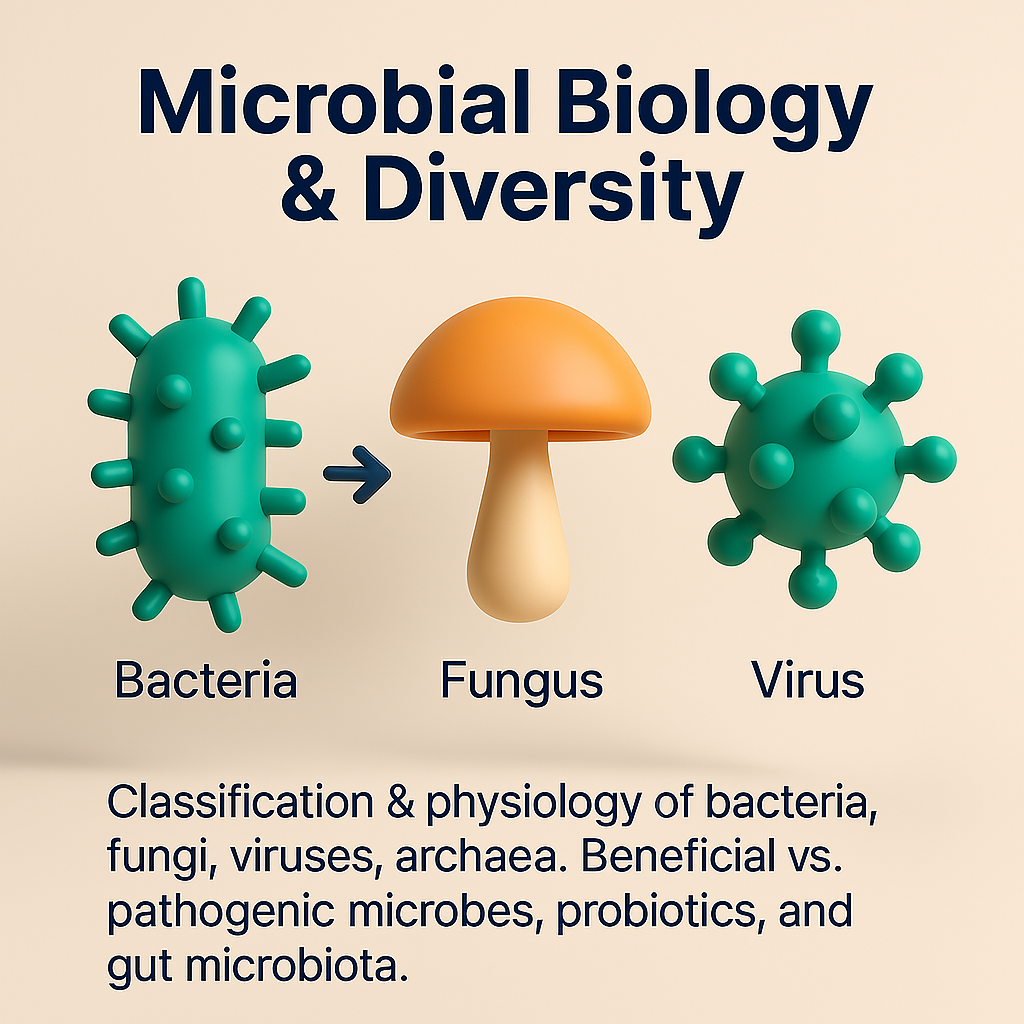
🌍 What is Microbial Biology & Diversity?
It’s the study of microorganisms — tiny life forms that you can’t see with the naked eye, but which have a huge impact on health, industry, and the environment.
It covers:
- Classification: How we group and name microbes.
- Physiology: How they grow, reproduce, get energy, survive stresses.
- Roles: From causing diseases (pathogens) to making yogurt & antibiotics (beneficial microbes).
🧬 Classification of microbes
🔬 Main groups include:
| Type | Examples | Key features |
|---|---|---|
| Bacteria | E. coli, Streptococcus | Prokaryotes (no nucleus), diverse shapes (cocci, bacilli, spirilla), reproduce by binary fission |
| Archaea | Halophiles, methanogens | Prokaryotes, but different cell wall lipids, live in extreme environments |
| Fungi | Yeasts (Saccharomyces), molds | Eukaryotes, cell walls of chitin, important decomposers & fermenters |
| Viruses | HIV, influenza, bacteriophages | Acellular, need host to replicate, genomes of DNA or RNA |
🔬 Physiology — how microbes live
- Metabolism: Some are aerobic (need oxygen), others anaerobic.
- Nutrition: Heterotrophs (need organic carbon) vs. autotrophs (make their own food).
- Growth: Exponential growth phases (lag, log, stationary, death) seen in microbial culture curves.
🩺 Beneficial vs. pathogenic microbes
| Type | Examples & role |
|---|---|
| Beneficial microbes | Lactobacillus in yogurt, nitrogen-fixing Rhizobium, yeast in bread & beer |
| Pathogenic microbes | Mycobacterium tuberculosis (TB), HIV (AIDS), Candida causing fungal infections |
| Probiotics & gut flora | Bifidobacterium, Lactobacillus — aid digestion, immunity |
🔄 Mini flowchart: Understanding microbial impact
Microbes
↓
Classification ➔ Bacteria, Fungi, Viruses, Archaea
↓
Physiology ➔ Growth, metabolism, stress survival
↓
Impact ➔
• Beneficial: Fermentation, probiotics, biotech enzymes
• Pathogenic: Cause diseases, spoil food
📝 Example case study: Gut microbiota & probiotics
🦠 Scenario
A student learns that taking antibiotics often causes digestive upset. Why?
🔍 What’s happening?
- Antibiotics don’t just kill pathogens — they also reduce beneficial gut bacteria like Lactobacillus and Bifidobacterium.
- This disrupts the balance, allowing harmful microbes to overgrow.
💊 How probiotics help
- Eating probiotic-rich foods (curd, kefir, kombucha) helps restore healthy gut flora, improving digestion and immunity.
✅ Short summary table
| Microbe group | Examples | Why important |
|---|---|---|
| Bacteria | E. coli, Lactobacillus | Digest food, fix nitrogen, make antibiotics, some cause disease |
| Fungi | Yeasts, Aspergillus | Make bread, beer, antibiotics (Penicillium), some infections |
| Viruses | Flu virus, COVID-19 | Infect plants, animals, humans; also used in gene therapy |
| Archaea | Methanogens, halophiles | Important in extreme environments, wastewater treatment |
